ھندي
هندي ٻولي (Hindi) ڀارت جي سڀ کان وڏي هندو آريائي ٻولي يا ڏيهي آريا ٻولي آهي جيڪا اتر ڀارت ۾ ڳالهائبي آهي.[10]
| هندي | |
|---|---|
| हिन्दी (ديوناگري) | |
 ديوناگري لپي ۾ لفظ "هندي" | |
| اچار | ˈɦɪndi |
| ٻولي جو وطن | انڊيا |
| خطو | هندي بيلٽ (مغربي اتر پرديش، دهلي) |
| نسل | ھندي ٻولڻ وارا |
ٻولي ڳالهائيندڙ |
[1][2] پينٽيهه ڪروڙ (350 ملين) هندي ۽ مختلف لاڳاپيل ٻولين جا ڳالهائيندڙ جن هندي کي پنهنجي مادري ٻولي جي طور ٻڌايو (2011ع جي مردم شماري) ڇويهه ڪروڙ (260 ملين) جنهن هندي کي پنهنجي ٻي ٻولي طور ٻڌايو (2020ع)[2] |
پراڻيون صورتون |
شوراسيني پراڪرت
|
| * ديوناگري (سرڪاري) | |
| اشارن واري هندي | |
| سرڪاري حيثيت | |
سرڪاري ٻولي وغيره |
|
اقليت جي ٻولي |
|
| ريگيوليٽر | مرڪزي هندي ڊائريڪٽوريٽ[8] |
| ٻولي جا ڪوڊ | |
| ISO 639-1 | hi |
| ISO 639-2 | hin |
| ISO 639-3 | hin |
hin-hin | |
| گلوٽولوگ | hind1269[9] |
| لنگاسفيئر | 59-AAF-qf |
 سال 2011ع جي مردم شماري مطابق هندستان ۾ خود رپورٽ ٿيل، L1 هندي ڳالهائيندڙن جي ورڇ. | |
جديد معياري هندي (آधुनिक मानक हिन्दी) عام طور تي هندي طور حوالو ڏنو ويو آهي، هڪ هند-آريائي ٻولي آهي جيڪا ديوناگري لپي ۾ لکيل آهي. اها انگريزيءَ سان گڏ هندستان جي سرڪاري ٻولي ۽ اتر هندستان جي عام گالهه ٻول جي زبان (lingua franca) آهي. ھندي کي ھندوستاني ٻوليءَ جو سنسڪرت رجسٽر سمجھيو ويندو آھي، جيڪو خود بنيادي طور دهلي ۽ ڀرپاسي وارن علائقن جي خريبولي ٻولي تي ٻڌل آھي. اها نو رياستن ۽ ٽن يونين علائقن ۾ سرڪاري ٻولي آهي ۽ ٽن ٻين رياستن ۾ هڪ اضافي سرڪاري ٻولي آهي. هندي پڻ جمهوريه هندستان جي 22 شيڊول ٻولين مان هڪ آهي. ھندي به ڳالھائي وڃي ٿي، ٿوري حد تائين، ھندوستان جي ٻين حصن ۾ (عام طور تي ھڪڙي سادي يا پڊگنائز ٿيل قسم ۾، جيئن بازار ھندوستاني يا ھافلونگ ھندي). هندستان کان ٻاهر، ڪيتريون ئي ٻيون ٻوليون سرڪاري طور تي ”هندي“ طور سڃاتل آهن پر هتي بيان ڪيل معياري هندي ٻولي جو حوالو نه ڏيو ۽ ان جي بدران ٻين ويجهن ٻولين جهڙوڪ اوهدي ۽ ڀوجپوري مان نڪتل آهن. اهڙين ٻولين ۾ شامل آهن فجي هندي، جنهن کي سرڪاري حيثيت حاصل آهي فجي ۽ ڪيريبين هندستاني، جيڪا سرينام، ٽرينيڊاد ۽ ٽوباگو ۽ گيانا ۾ ڳالهائي وڃي ٿي. رسم الخط ۽ رسم الخط کان سواءِ، معياري هندي، معياري اردو، هندستاني جي هڪ ٻي تسليم ٿيل رجسٽر سان هڪجهڙائي سان سمجھ ۾ اچي ٿي، ڇاڪاڻ ته هندي ۽ اردو ٻنهي جو بنيادي لفظ پراڪرت (سنسڪرت جو اولاد) مان نڪتل آهي. ھندي دنيا ۾ چوٿون سڀ کان وڌيڪ ڳالھائيندڙ ٻولي آھي، مانڊرين، اسپينش ۽ انگريزي کان پوءِ. جيڪڏھن ھڪ ٻئي سان سمجھ ۾ ايندڙ اردوءَ کي گڏ ڪيو وڃي، ته ھي دنيا جي ٽيون نمبر تي سڀ کان وڌيڪ ڳالھائي ويندي آھي، انگريزي ۽ Mandarin کان پوءِ. Ethnologue (2022، 25 هين ايڊيشن) جي رپورٽن مطابق هندي دنيا ۾ ٽيون سڀ کان وڌيڪ ڳالهائيندڙ ٻولي آهي جنهن ۾ پهرين ۽ ٻي ٻولي ڳالهائيندڙ شامل آهن. هندستان جي 2011 جي مردم شماري جي مطابق، هندي، هندستان جي تيز ترين وڌندڙ ٻولي آهي، ٻئي نمبر تي ڪشميري، ميٽي (سرڪاري طور تي منيپوري) سان گڏ گڏوگڏ گجراتي، ٽئين نمبر تي، ۽ بنگالي چوٿين نمبر تي، هندستان جي 2011 جي مردم شماري مطابق.
Modern Standard Hindi (आधुनिक मानक हिन्दी, Ādhunik Mānak Hindī),[11] commonly referred to as Hindi, is an Indo-Aryan language written in Devanagari script. It is the official language of India alongside English and the lingua franca of North India. Hindi is considered a Sanskritised register[12] of the Hindustani language, which itself is based primarily on the Khariboli dialect of Delhi and neighbouring areas.[13][14][15] It is an official language in nine states and three union territories and an additional official language in three other states.[16][17][18][19] Hindi is also one of the 22 scheduled languages of the Republic of India.[20]
Hindi is also spoken, to a lesser extent, in other parts of India (usually in a simplified or pidginised variety such as Bazaar Hindustani or Haflong Hindi).[16][17] Outside India, several other languages are recognised officially as "Hindi" but do not refer to the Standard Hindi language described here and instead descend from other nearby languages, such as Awadhi and Bhojpuri. Such languages include Fiji Hindi, which has an official status in Fiji,[21] and Caribbean Hindustani, which is spoken in Suriname, Trinidad and Tobago, and Guyana.[22][23][24][25] Apart from the script and formal vocabulary, standard Hindi is mutually intelligible with standard Urdu, another recognised register of Hindustani, as both Hindi and Urdu share a core vocabulary base derived from Prakrit (a descendant of Sanskrit).[26][27][28][29]
Hindi is the fourth most-spoken first language in the world, after Mandarin, Spanish and English.[30] If counted together with the mutually intelligible Urdu, it is the third most-spoken language in the world, after Mandarin and English.[31][32] According to reports of Ethnologue (2022, 25th edition) Hindi is the third most-spoken language in the world including first and second language speakers.[33]
Hindi is the fastest growing language of India, followed by Kashmiri in the second place, with Meitei (officially called Manipuri) as well as Gujarati, in the third place, and Bengali in the fourth place, according to the 2011 census of India.[34]
حوالا
سنواريو- ↑ "Scheduled Languages in descending order of speaker's strength - 2011" (PDF). Registrar General and Census Commissioner of India.
- ↑ 2.0 2.1 سانچو:E27
- ↑ 3.0 3.1 سانچو:ELL2
- ↑ Gangopadhyay, Avik (2020). Glimpses of Indian Languages. Evincepub publishing. pp. 43. ISBN 9789390197828.
- ↑ Palakodety, Shriphani; KhudaBukhsh, Ashiqur R.; Jayachandran, Guha, "Low Resource Machine Translation", Low Resource Social Media Text Mining (Singapore: Springer Singapore), صفحا. 7–9, ISBN 978-981-16-5624-8, ISSN 2191-5768, doi:10.1007/978-981-16-5625-5_5, حاصل ڪيل 24 September 2022 Unknown parameter
|s2cid=ignored (مدد) - ↑ "Constitution of the Republic of South Africa, 1996 – Chapter 1: Founding Provisions". www.gov.za. حاصل ڪيل 6 December 2014.
- ↑ "Abu Dhabi includes Hindi as third official court language". The Hindu. 10 February 2019. https://www.thehindu.com/news/international/abu-dhabi-includes-hindi-as-third-official-court-language/article26229023.ece.
- ↑ "About Us". Central Hindi Directorate. وقت 4 May 2012 تي اصل کان آرڪائيو ٿيل. حاصل ڪيل 18 February 2014. Unknown parameter
|url-status=ignored (مدد) - ↑ Hammarström, Harald; Forkel, Robert; Haspelmath, Martin et al., eds (2016). "Hindi". Glottolog 2.7. Jena: Max Planck Institute for the Science of Human History. http://glottolog.org/resource/languoid/id/hind1269.
- ↑ "Hindi language" (en ۾). Encyclopedia Britannica. https://www.britannica.com/topic/Hindi-language.
- ↑ Singh, Rajendra, and Rama Kant Agnihotri. Hindi morphology: A word-based description. Vol. 9. Motilal Banarsidass Publ., 1997.
- ↑ "The Constitution of India". lawmin.nic.in. وقت 2 April 2012 تي اصل کان آرڪائيو ٿيل. حاصل ڪيل 21 March 2012. Unknown parameter
|url-status=ignored (مدد) - ↑ "About Hindi-Urdu". North Carolina State University. وقت 15 August 2009 تي اصل کان آرڪائيو ٿيل. حاصل ڪيل 9 August 2009. Unknown parameter
|url-status=ignored (مدد) - ↑ Basu, Manisha (2017) (en ۾). The Rhetoric of Hindutva. Cambridge University Press. ISBN 978-1-107-14987-8. https://books.google.com/books?id=E7gtDQAAQBAJ. "Urdu, like Hindi, was a standardized register of the Hindustani language deriving from the Delhi dialect and emerged in the eighteenth century under the rule of the late Mughals."
- ↑ Peter-Dass, Rakesh (2019) (en ۾). Hindi Christian Literature in Contemporary India. Routledge. ISBN 978-1-00-070224-8. https://books.google.com/books?id=hxmvDwAAQBAJ. "Two forms of the same language, Nagarai Hindi and Persianized Hindi (Urdu) had identical grammar, shared common words and roots, and employed different scripts."
- ↑ 16.0 16.1 Kawoosa, Vijdan Mohammad (22 November 2018). "How languages intersect in India". Hindustan Times. https://www.hindustantimes.com/india-news/how-languagesintersect-in-india/story-g3nzNwFppYV7XvCumRzlYL.html.
- ↑ 17.0 17.1 "How many Indians can you talk to?". Hindustan Times. وقت 16 December 2019 تي اصل کان آرڪائيو ٿيل. حاصل ڪيل 22 December 2019. Unknown parameter
|url-status=ignored (مدد) - ↑ Saravanan, Depak. "Hindi and the North-South divide". Deccan Herald. وقت 23 November 2022 تي اصل کان آرڪائيو ٿيل. Unknown parameter
|url-status=ignored (مدد) - ↑ Pillalamarri, Akhilesh. "India's Evolving Linguistic Landscape". The Diplomat. وقت 1 June 2019 تي اصل کان آرڪائيو ٿيل. حاصل ڪيل 22 December 2019. Unknown parameter
|url-status=ignored (مدد) - ↑ "PART A Languages specified in the Eighth Schedule (Scheduled Languages)". Census of India. وقت 29 October 2013 تي اصل کان آرڪائيو ٿيل.
- ↑ "How Hindi travelled to these five countries from India". The Indian Express. وقت 29 December 2022 تي اصل کان آرڪائيو ٿيل. Unknown parameter
|url-status=ignored (مدد) - ↑ "Sequence of events with reference to official language of the Union". Department of Official Language. وقت 2 August 2011 تي اصل کان آرڪائيو ٿيل. Unknown parameter
|url-status=ignored (مدد) - ↑ "रिपब्लिक ऑफ फीजी का संविधान (Constitution of the Republic of Fiji, the Hindi version)". Fiji Government. وقت 1 November 2013 تي اصل کان آرڪائيو ٿيل. Unknown parameter
|url-status=ignored (مدد) - ↑ "Caribbean Languages and Caribbean Linguistics" (PDF). University of the West Indies Press. وقت 20 December 2016 تي اصل (PDF) کان آرڪائيو ٿيل. حاصل ڪيل 16 July 2016. Unknown parameter
|url-status=ignored (مدد) - ↑ Richard K. Barz (8 May 2007). "The cultural significance of Hindi in Mauritius". South Asia: Journal of South Asian Studies 3: 1–13. doi:.
- ↑ Gube, Jan; Gao, Fang (2019) (en ۾). Education, Ethnicity and Equity in the Multilingual Asian Context. Springer Publishing. ISBN 978-981-13-3125-1. https://books.google.com/books?id=YkWHDwAAQBAJ. "The national language of India and Pakistan 'Standard Urdu' is mutually intelligible with 'Standard Hindi' because both languages share the same Indic base and are all but indistinguishable in phonology and grammar (Lust et al. 2000)."
- ↑ Chatterji, Suniti Kumar; Siṃha, Udaẏa Nārāẏana; Padikkal, Shivarama (1997) (en ۾). Suniti Kumar Chatterji: a centenary tribute. Sahitya Akademi. ISBN 978-81-260-0353-2. "High Hindi written in Devanagari, having identical grammar with Urdu, employing the native Hindi or Hindustani (Prakrit) elements to the fullest, but for words of high culture, going to Sanskrit. Hindustani proper that represents the basic Khari Boli with vocabulary holding a balance between Urdu and High Hindi."
- ↑ Yoon, Bogum; Pratt, Kristen L., eds (15 January 2023) (English ۾). Primary Language Impact on Second Language and Literacy Learning. Lexington Books. p. 198. "In terms of cross-linguistic relations, Urdu's combinations of Arabic-Persian orthography and Sanskrit linguistic roots provides interesting theoretical as well as practical comparisons demonstrated in table 12.1."
- ↑ "Ties between Urdu & Sanskrit deeply rooted: Scholar". The Times of India. حاصل ڪيل 8 May 2024.
The linguistic and cultural ties between Sanskrit and Urdu are deeply rooted and significant, said Ishtiaque Ahmed, registrar, Maula Azad National Urdu University during a two-day workshop titled "Introduction to Sanskrit for Urdu medium students". Ahmed said a substantial portion of Urdu's vocabulary and cultural capital, as well as its syntactic structure, is derived from Sanskrit.
- ↑ Mikael Parkvall, "Världens 100 största språk 2007" (The World's 100 Largest Languages in 2007), in Nationalencyklopedin. Asterisks mark the 2010 estimates آرڪائيو ڪيا ويا 11 November 2012 حوالو موجود آهي وي بيڪ مشين. for the top dozen languages.
- ↑ Gambhir, Vijay (1995) (en ۾). The Teaching and Acquisition of South Asian Languages. University of Pennsylvania Press. ISBN 978-0-8122-3328-5. https://books.google.com/books?id=mB7TQc_OpdcC. "The position of Hindi-Urdu among the languages of the world is anomalous. The number of its proficient speakers, over three hundred million, places it in third of fourth place after Mandarin, English, and perhaps Spanish."
- ↑ "Hindustani". Columbia University Press. وقت 29 July 2017 تي اصل کان آرڪائيو ٿيل. Unknown parameter
|url-status=ignored (مدد) - ↑ "What are the top 200 most spoken languages?". Ethnologue (Free All). حاصل ڪيل 31 March 2023.
- ↑ —R, Aishwaryaa (6 June 2019). "What census data reveals about use of Indian languages". Deccan Herald. https://www.deccanherald.com/india/what-census-data-reveals-about-use-of-indian-languages-738340.html.
—Pallapothu, Sravan (28 June 2018). "Hindi Added 100Mn Speakers In A Decade; Kashmiri 2nd Fast Growing Language". https://www.indiaspend.com/hindi-added-100mn-speakers-in-a-decade-kashmiri-2nd-fast-growing-language-93096/.
—IndiaSpend (2 July 2018). "Hindi fastest growing language in India, finds 100 million new speakers". Business Standard. https://www.business-standard.com/article/current-affairs/hindi-fastest-growing-language-in-india-finds-100-million-new-speakers-118070200029_1.html.
—Mishra, Mayank; Aggarwal, Piyush. "Hindi grew rapidly in non-Hindi states even without official mandate". India Today. حاصل ڪيل 16 November 2023.